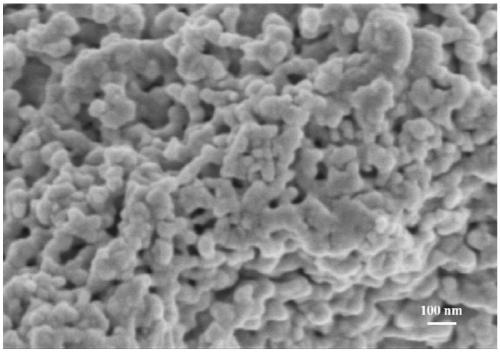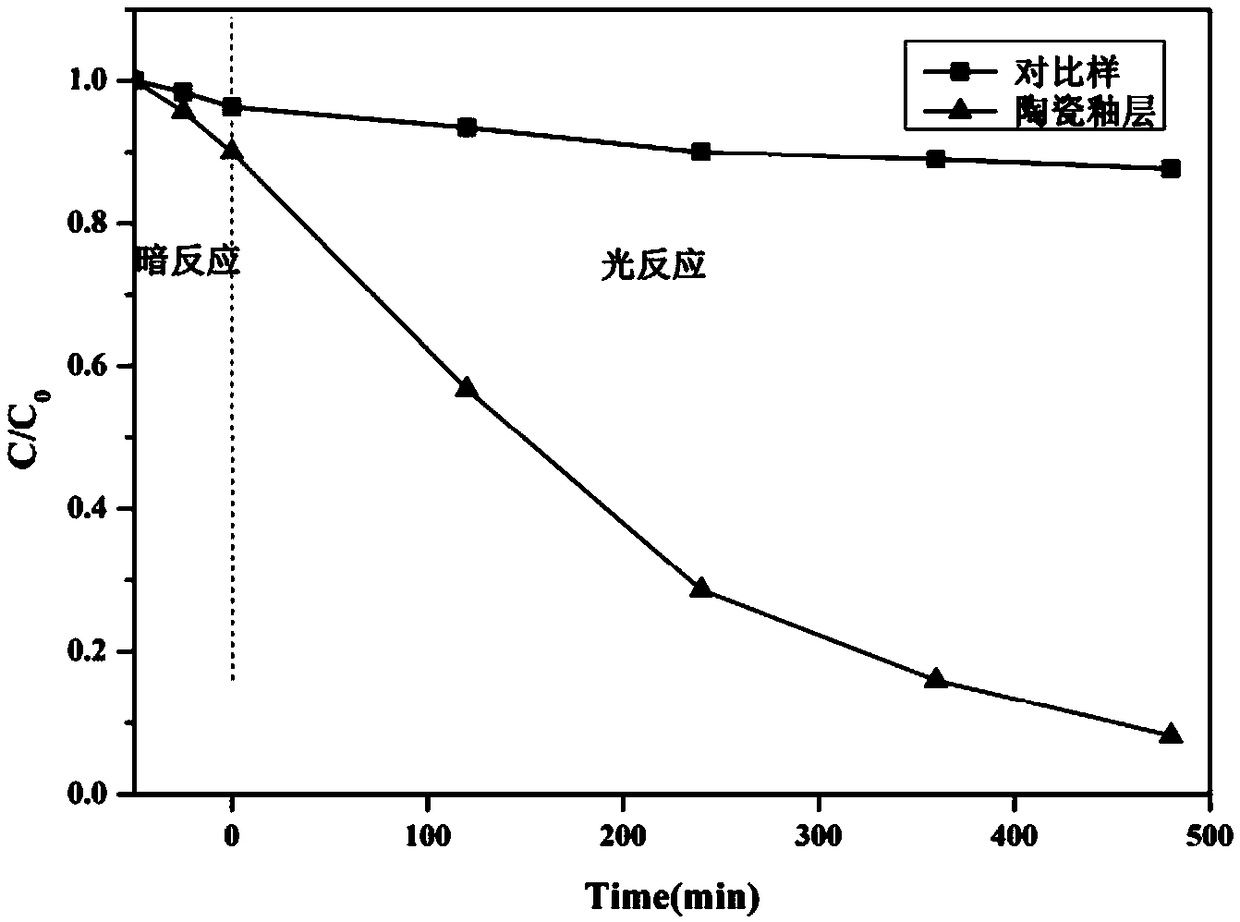A kind of preparation method of bismuth zirconate microcrystalline ceramic glaze with photocatalytic function
A bismuth zirconate and photocatalysis technology, applied in the field of ceramic glazes, can solve the problems of poor bonding between photocatalytic films and substrates, uneven distribution of photocatalyst glazes, and affecting the aesthetics of ceramics, achieving good visible light response and improving light Good catalytic performance and surface decoration effect
- Summary
- Abstract
- Description
- Claims
- Application Information
AI Technical Summary
Problems solved by technology
Method used
Image
Examples
Embodiment 1
[0031] 1) First, quartz, potassium feldspar, albite, borax, Bi 2 o 3 , Suzhou soil, lithium carbonate and other raw materials are prepared according to the following mass chemical composition ratios. SiO 2 :Al 2 o 3 :B 2 o 3 : Bi 2 o 3 : Li 2 O: Na 2 O:K 2 O=57:4:22:4:7:4:3.
[0032] 2) Dry mix and grind the above-mentioned powders, pass through a 60-mesh sieve to obtain the mixture, put it into a crucible, put it into an electric furnace and keep it at 1270°C for 20 minutes, take it out and pour it into water to quench to make a frit. Take out the frit from the water, put it into a ball mill after drying, and grind it finely. The mass ratio of control material (frit): ball: water is 1:1:0.8, pass through a 250-mesh sieve after grinding for 3 hours, and dry for later use. This powder is denoted as A material.
[0033] 3) Combine the above material A and Bi 2 o 3 , ZrO 2 And the mass ratio of Suzhou soil is A: Bi 2 o 3 : Suzhou soil = 82:7.4:7 ratio for batchi...
Embodiment 2
[0039] 1) First, quartz, potassium feldspar, albite, borax, Bi 2 o 3 , Suzhou soil, lithium carbonate and other raw materials are prepared according to the following mass chemical composition ratios. SiO 2 :Al 2 o 3 :B 2 o 3 : Bi 2 o 3 : Li 2 O: Na 2 O:K 2 O=58:5:23:3:6:3:2.
[0040] 2) Dry mix and grind the above-mentioned powders, pass through a 60-mesh sieve to obtain the mixture, put it into a crucible, put it into an electric furnace and keep it warm at 1280°C for 30 minutes, take it out and pour it into water to quench to make a frit. Take the frit out of the water, put it into a ball mill after drying, and grind it finely. The mass ratio of control material (frit): ball: water is 1:1:0.8, pass through a 250-mesh sieve after grinding for 4 hours, and dry for later use. This powder is denoted as A material.
[0041] 3) Combine the above material A and Bi 2 o 3 , ZrO 2 And the mass ratio of Suzhou soil is A: Bi 2 o 3 : Suzhou soil = 84: 7.2: 6 ratio for b...
Embodiment 3
[0045] 1) First, quartz, potassium feldspar, albite, borax, Bi 2 o 3 , Suzhou soil, lithium carbonate and other raw materials are prepared according to the following mass chemical composition ratios. SiO 2 :Al 2 o 3 :B 2 o 3 : Bi 2 o 3 : Li 2 O: Na 2 O:K 2 O=59:6:24:2:5:2:1.
[0046] 2) Dry mix and grind the above-mentioned powders, pass through a 40-mesh sieve to obtain the mixture, put it into a crucible, put it in an electric furnace at 1290° C. for 40 minutes, take it out and pour it into water to quench to obtain a frit. Take out the frit from the water, put it into a ball mill after drying, and grind it finely. The mass ratio of control material (frit): ball: water is 1:1:0.8, pass through a 250-mesh sieve after grinding for 3 hours, and dry for later use. This powder is denoted as A material.
[0047] 3) Combine the above material A and Bi 2 o 3 , ZrO 2 And the mass ratio of Suzhou soil is A: Bi 2 o 3 : Suzhou soil = 86:7:5 ratio for batching, and Bi ...
PUM
| Property | Measurement | Unit |
|---|---|---|
| size | aaaaa | aaaaa |
| particle size | aaaaa | aaaaa |
Abstract
Description
Claims
Application Information
 Login to View More
Login to View More - R&D
- Intellectual Property
- Life Sciences
- Materials
- Tech Scout
- Unparalleled Data Quality
- Higher Quality Content
- 60% Fewer Hallucinations
Browse by: Latest US Patents, China's latest patents, Technical Efficacy Thesaurus, Application Domain, Technology Topic, Popular Technical Reports.
© 2025 PatSnap. All rights reserved.Legal|Privacy policy|Modern Slavery Act Transparency Statement|Sitemap|About US| Contact US: help@patsnap.com


